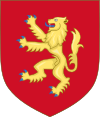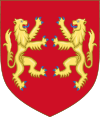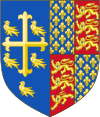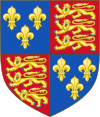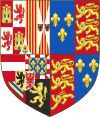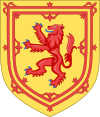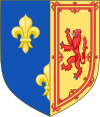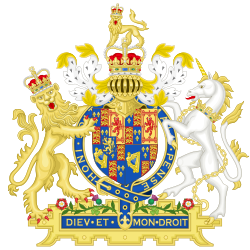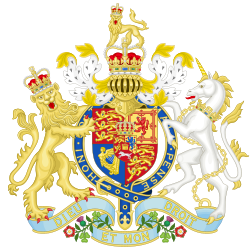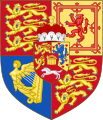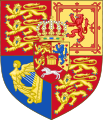Gebruiker:Quichot/Werk
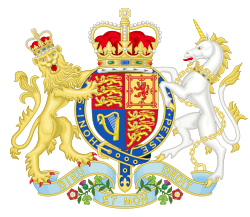
Het Wapen van het Verenigd Koninkrijk (Engels: Royal Coat of Arms of the United Kingdom) is het officiele wapen van de Britse monarch, nu Koningin Elizabeth II. Dit wapen wordt gebruikt door de koningin in haar hoedaingheid als monarch, en is iffieel bekend als haar Arms of Dominion. Varianten van het wapen worden geruikt door andere leden van het Britse koninklijke familie en door de overheid van het Verenigd Koninkrijk. De koningin heeft in Schotland en andere versie van het wapen, waar weer een variant van in gebruik is bij het Scotland Office (De schotse gouvernementele vertegenwoordiging in de Briste overheid.
The shield is quartered, depicting in the first and fourth quarters the three lions passant guardant of England; in the second, the rampant lion and double tressure fleury-counter-fleury of Scotland; and in the third, a harp for Ireland.
The crest is a lion statant guardant wearing the imperial crown, itself on another representation of that crown.
The dexter supporter is a likewise crowned lion, symbolizing England; the sinister, a unicorn, symbolising Scotland. According to legend a free unicorn was considered a very dangerous beast; therefore the heraldic unicorn is chained,[1] as were both supporting unicorns in the Royal coat of arms of Scotland.
The coat features both the motto of English monarchs, Dieu et mon droit (God and my right), and the motto of the Order of the Garter, Honi soit qui mal y pense (Shamed be he who thinks ill of it) on a representation of the Garter behind the shield.
The official blazon of the Royal Arms is as follows:
- Quarterly, first and fourth Gules three lions passant gardant in pale Or armed and langued Azure (for England), second quarter Or a lion rampant within a double tressure flory-counter-flory Gules (for Scotland), third quarter Azure a harp Or stringed Argent (for Ireland), the whole surrounded by the Garter; for a Crest, upon the Royal helm the imperial crown Proper, thereon a lion statant gardant Or imperially crowned Proper; Mantling Or and ermine; for Supporters, dexter a lion rampant gardant Or crowned as the Crest, sinister a unicorn Argent armed, crined and unguled Proper, gorged with a coronet Or composed of crosses patée and fleurs de lis a chain affixed thereto passing between the forelegs and reflexed over the back also Or. Motto 'Dieu et mon Droit' in the compartment below the shield, with the Union rose, shamrock and thistle engrafted on the same stem.[2]
Scotland[bewerken | brontekst bewerken]
The Queen has a separate version of her arms for use in Scotland, giving the Scottish elements pride of place.
The shield is quartered, depicting in the first and fourth quarters the lion rampant of Scotland; in the second, the three lions passant guardant of England; and in the third, the harp of Ireland.
The crest atop the Crown of Scotland is a red lion, seated and forward facing, itself wearing the Crown of Scotland and holding the two remaining elements of the Honours of Scotland, namely the Sword of State and the Sceptre of Scotland. This was also the crest used in the Royal Arms of the Kingdom of Scotland. The motto, in Scots, appears above the crest, in the tradition of Scottish heraldry, and is an abbreviated form of the full motto: In My Defens God Me Defend.
The supporters change sides and both appear wearing the crowns of their respective Kingdom. The dexter supporter is a crowned and chained unicorn, symbolising Scotland. The sinister supporter is a crowned lion, symbolising England. Between each supporter and the shield is a lance displaying the flag of their respective Kingdom.
The coat also features both the motto Nemo me impune lacessit (No-one wounds (touches) me with impunity) and, surrounding the shield, the collar of the Order of the Thistle.
Other nations in the United Kingdom[bewerken | brontekst bewerken]
The official Irish royal crest (on a wreath Or and Azure, a tower triple-towered of the First, from the portal a hart springing Argent attired and unguled Or) is rarely if ever seen on the arms of the United Kingdom, as, unlike the Act of Union 1707 with Scotland, the Act of Union 1800 with Ireland did not provide for a separate Irish version of the royal arms.
However, the harp quarter of the Royal Arms represents Ireland on both the English and Scottish versions. Likewise, one English quarter is retained in the Scottish version, and one Scottish quarter is retained in the English version. Thus, England, Scotland and Ireland are represented in all versions of the Royal Arms since they came under one monarch.
By contrast, there is no representation at all for Wales in the Royal Arms, as at the Act of Union 1707 Wales was considered an integral part of England pursuant to the Laws in Wales Acts 1535-1542, thus it can be argued Wales is represented in the English coat of arms. Wales was a kingdom when ruled by native Kings, some of whom united it under one Crown, but with the English conquest it largely ceased to exist as a distinct legal entity. The Prince of Wales has ever since been the monarch's heir apparent.
Upon the accession of the Tudor Kings and Queens, who were themselves of Welsh descent, a Welsh dragon was used as a supporter on the Royal Arms. This was dropped by their successors, the Scottish House of Stuart, who replaced the Tudors' dragon supporter with the Scottish unicorn.
In the twentieth century, the arms of the principality of Wales were added as an inescutcheon to the coat of arms of the Prince of Wales, and a banner of those arms with a green inescutcheon bearing the Prince's crown is flown as his personal standard in Wales. The so-called Prince of Wales's feathers are a heraldic badge rather than a coat of arms upon a shield, but they are not Welsh in any case. They derive, in fact, from the English Princes of Wales (who allegedly owe them to an exploit of Edward, the Black Prince at the Battle of Crécy) and carry a German motto. In any event, they do not form part of the Royal Arms, as opposed to the heraldic achievement of the Prince of Wales, who drops them upon his accession as King.
Uses[bewerken | brontekst bewerken]

The Royal Arms as shown above may only be used by the Queen herself. They also appear in court rooms, since the monarch is the fount of justice in the UK and the law Court is part of the Court of the monarch (hence its name). Judges are officially representatives of the crown, demonstrated by the Queen's Coat of Arms which sits behind the judge on the wall of every court in the land, with the exception of the magistrates court in the City of London, in which a sword stands vertically behind the judge which is flanked by the arms of the City and the Crown.
The British Government also uses the Royal Coat of Arms as a national symbol of the United Kingdom, and, in that capacity, the Coat of Arms can be seen on several government documents and forms, passports, in the entrance to embassies and consulates, etc. However, when used by the government and not by the sovereign herself, the coat of arms is often represented without the helm. This is also the case with the sovereign's Scottish arms, a version of which is used by the Scotland Office.
The Royal Arms have regularly appeared on the coinage produced by the Royal Mint including, for example, from 1663, the Guinea and, from 1983, the British one pound coin. In 2008, a new series of designs for all seven coins of £1 and below was unveiled by the Royal Mint, every one of which is drawn from the Royal Arms. The full Royal Arms appear on the one pound coin, and sections appear on each of the other six, such that they can be put together like a puzzle to make another complete representation of the Royal Arms.[3]
The Queen awards Royal Warrants to various businesses that supply the Royal Household. This allows the business to display the Royal Arms on their packaging and stationery.
A banner of the arms, the Royal Standard is flown from the Royal Palaces when the Queen is in residence; and from public buildings only when the Queen is present. At royal residences such as Windsor Castle or Buckingham Palace, the Queen's main residence, the Royal Standard is flown to indicate when the monarch is in residence. This protocol equally applies to the monarch's principal residences in Scotland, (Holyrood Palace and Balmoral Castle), where the Royal Standard as used in Scotland is flown. When the monarch is not in residence the Union Flag, or in Scotland the ancient Royal Standard of Scotland, is flown.
The Royal Arms is also a symbol for all the courts in British Columbia, Canada, as the Commission under which judges sit within its courts' rooms.[4]
The royal arms is also used as a symbol for all the State courts and Viceroys of Australia to represent the power of the monarchy.
History[bewerken | brontekst bewerken]
The current Royal Arms are a combination of the arms of the Kingdoms that make up the United Kingdom, and can be traced back to the first arms of the Kings of England and Kings of Scots. Various alterations occurred over the years as the arms of other realms acquired or claimed by the Kings were added to the Royal Arms. The table below tracks the changes in the Royal Arms from the original arms of King Henry II of England, and William I, King of Scots.
| |||||||||||||||||||||||||||||||||||||||||||||||||||||||||||||||||||||||||||||||||||||||||||||||||
Other variants[bewerken | brontekst bewerken]
Royal Family[bewerken | brontekst bewerken]
Members of the (British Royal Family) receive their own personalised arms which are based on the Royal Arms. Only children and grandchildren in the male line of the monarch are entitled to receive their own arms in this fashion. The arms of children of the monarch are differentiated by a three point label; grandchildren of the monarch are differentiated by a five point label. An exception is made for the eldest son of the Prince of Wales, who received a three point label. Since 1911, the arms of the Prince of Wales also has an inescutcheon of the ancient arms of the Principality of Wales.
Queens consort and the wives of sons of the monarch also receive their own personalised coat of arms. Typically this will be the arms of their husband impaled with their own personal arms or those of their father. However, the consorts of a Queen regnant are not entitled to use the Royal Arms. Thus Prince Philip, Duke of Edinburgh uses his own personal arms.
Currently the following members of the Royal Family have their own arms based on the Royal Arms:
| Children and grandchildren of the monarch in the male line | ||
| Arms/Standard | Bearer | Difference |
|---|---|---|
 |
HRH The Prince of Wales | Plain three-point label, and inescutcheon of the Coat of Arms of the Principality of Wales.[2] |
 |
HRH Prince William of Wales | Three-point label with a red escallop, alluding to the arms of his mother, Lady Diana Spencer. |
 |
HRH Prince Henry of Wales | Five-point label with three red escallops in alternate points. |
 |
HRH The Duke of York | Three-point label, the centre point bearing a blue anchor.[2] |
 |
HRH Princess Beatrice of York | Five-point label with three Bees in alternate points. |
 |
HRH Princess Eugenie of York | Five-point label with three Thistle in alternate points. |
 |
HRH The Earl of Wessex | Three-point label, the centre point bearing a Tudor rose. |
 |
HRH The Princess Royal | Three-point label, the points bearing a red cross, a red heart and a red cross.[2] |
 |
HRH The Duke of Gloucester | Five-point label, the first, third and fifth points bearing a red cross, the second and fourth points bearing a red lion.[2] |
 |
HRH The Duke of Kent | Five-point label, the first, third and fifth points bearing a blue anchor, the second and fourth points bearing a red cross.[2] |
 |
HRH Prince Michael of Kent | Five-point label, the first, third and fifth points bearing a red cross, the second and fourth points bearing a blue anchor.[2] |
 |
HRH Princess Alexandra | Five-point label, the first and fifth points bearing a red heart, the second and fourth points bearing a blue anchor, and the third bearing a red cross.[2] |
| Consorts | ||
 |
HRH The Duke of Edinburgh | Prince Philip was granted arms of his own in 1947, because men are not entitled to bear the arms of their wives. His arms are quarterly Denmark, Greece, and Mountbatten, representing his ancestry, and Edinburgh, representing his dukedom.[2] |
 |
HRH The Duchess of Cornwall | The arms of the Prince of Wales impaled with those of her father, Major Bruce Shand, crowned by the single-arched Crown of Prince of Wales.[9] |
 |
HRH The Countess of Wessex | The arms of the Earl of Wessex impaled with her own personal arms. |
Government[bewerken | brontekst bewerken]


Her Majesty's Government uses a version of the Royal Arms but without the helm or crest, as a result of which the crown sits atop the shield. In relation to Scotland, the Scotland Office uses the Scottish version, again without the helm or crest, and the same was used as the day-to-day logo of the Scottish Executive until September 2007, when a rebranding exercise introduced the name Scottish Government, together with a revised logo incorporating the flag of Scotland.
The Arms feature on
- All Acts of Parliament;
- The cover of all UK passports; and
- As an inescutcheon on the Diplomatic flags for a British Ambassador
It is also used by the following government departments
- The Foreign and Commonwealth Office;
- HM Treasury;
- Ministry of Justice
- Scotland Office (Scottish version)
- Court of Session (Scottish version)
- A version of the crest of the Royal Arms, as used in Scotland, is used by the Crown Office and Procurator Fiscal Service, the General Register Office for Scotland and the Royal Commission on the Ancient and Historical Monuments of Scotland.
- The shield of the Royal Arms with the motto of the Order of the Garter is used by the Home Office; and
- The shield of the Royal Arms is used by the Royal Mint.
- As the symbol of the Supreme Court of Newfoundland and Labrador in Canada.[2]
- As the symbol of the Courts of British Columbia in Canada. [3]
Blazon[bewerken | brontekst bewerken]
This table breaks down the official blazons to enable comparison of the differences between the general coat and the coat used in Scotland.
| Everywhere except Scotland | Scotland | |
|---|---|---|
| Quarterly I & IV | Gules three lions passant gardant in pale Or armed and langued Azure | Or a lion rampant Gules armed and langued Azure within a double tressure flory-counter-flory of the second |
| II | Or a lion rampant Gules armed and langued Azure within a double tressure flory-counter-flory of the second | Gules three lions passant gardant in pale Or armed and langued Azure |
| III | Azure a harp Or stringed Argent | |
| Surrounded by | The Garter | The collar of the Order of the Thistle |
| Crest | Upon the Royal helm the imperial crown Proper, thereon a lion statant gardant Or imperially crowned Proper | Upon the Royal helm the crown of Scotland Proper, thereon a lion sejant affronté Gules armed and langued Azure, Royally crowned Proper holding in his dexter paw a sword and in his sinister a sceptre, both Proper |
| Supporters |  |
 |
| Motto | Dieu et mon Droit (French) | In My Defens God Me Defend, abbr. In Defens (Scots) |
| Order Motto | Garter: Honi soit qui mal y pense (Old French) | Thistle: Nemo me impune lacessit (Latin) |
See also[bewerken | brontekst bewerken]
Referenties[bewerken | brontekst bewerken]
- ↑ Heraldic Sculptor| Accessed 29 April 2008
- ↑ a b c d e f g h i j k l m n o p q r s t u v w Brooke-Little, J.P., FSA (1978), Boutell's Heraldry, Revised Edition. Frederick Warne LTD, London [1950], 205–222. ISBN 0-7232-2096-4.
- ↑ The New Designs Revealed
- ↑ Welcome
- ↑ The Franco-Scots Coinage of Mary Stuart and Francis II
- ↑ Scottish Coins ~ Mary (1542 - 1567)
- ↑ a b François Velde's Heraldica site
- ↑ Arnaud Bunel's Héraldique européenne site
- ↑ BBC News "Camilla's coat of arms unveiled"
External links[bewerken | brontekst bewerken]
- Royal.gov.uk- Coat of Arms
- Number 10 Downing Street- Royal Coat of Arms
- Heraldica.org- The Royal Arms of Great Britain
United Kingdom United Kingdom Category:British monarchy United Kingdom Category:National symbols of the United Kingdom

